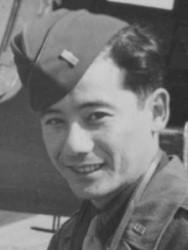
Henry Chiyei Oyasato
First Lieutenant
442nd Regimental Combat Team
2nd Battalion, F Company
Henry Chiyei Oyasato was born on February 6, 1922, in Koloa, Kauai, Territory of Hawaii. He was one of four sons and one daughter of Chimei and Ushie (Yakabi) Oyasato. His siblings were: George Chisei, Thomas Tomohiro, John Chiyoshi, and sister Aiko. Father Chinei arrived in 1903 from Okinawa Prefecture, Japan, and worked as a salesman in a retail store. Mother Ushie arrived from Okinawa in 1919.
In the 1940 Federal Census for Koloa, Henry and one brother were working as yard boys at a private home. His father was the proprietor of a general merchandise retail store, and one brother worked for the Koloa Sugar Mill, where the family lived in the plantation’s Korean Camp.
When the war broke out, Henry was attending the University of Hawaii and he joined the Hawaii Territorial Guard. With its inactivation, he became a member of the Varsity Victory Volunteers (VVV).
Oyasato signed his World War II Draft Registration card on June 4, 1942, Local Board No. 3 in Honolulu. At the time, he was living in YMCA’s Atherton House at the University of Hawaii in Honolulu. His point of contact was Walter C. Moore at Mid-Pacific Institute in Honolulu. And he was employed by and worked at the Corps of Engineers Auxiliary, 34th Engineers, Schofield Barracks, Oahu. He was 5’6” tall and weighed 127 pounds.
On March 23, 1943, Hank, as he was known, enlisted in the U.S. Army. The enlistment record states that he had two years of college and had served in the “National Guard in Federal Service.” He was sent to Boom Town, the tent city at Schofield Barracks where all the recent volunteers were housed. On March 28, they were given an aloha farewell ceremony by the community at Iolani Palace. On April 4, they left on the S.S. Lurline for San Francisco.
After arriving on the mainland, Oyasato and the rest of the new soldiers were sent by train to Camp Shelby, Mississippi, for training, arriving on April 18. Hank was assigned to the 2nd Battalion, F Company, 2nd Squad. In September 1943, he was promoted to Sergeant.
After a year of basic and specialized training and military exercises, they left by train for Camp Patrick Henry, Virginia, on April 22, 1944. On May 2, the 442nd left Hampton Roads in a convoy of over 100 troop ships, arriving in Naples, Italy, on May 28. After a week in a bivouac area in the nearby town of Bagnoli, they left on LSTs for Anzio.
The 442nd entered combat on June 26 near Suvereto in the Rome-Arno Campaign. Oyasato was present for all the action seen by the 442nd in Italy. They left for France on September 27.
Once they arrived in Marseilles, the Combat Team was in a bivouac area in nearby Septèmes until October 9, when they were transported north to participate in the Rhineland-Vosges Campaign. In October-November, the 442nd liberated the important road junction of Bruyères, followed by Biffontaine, and the famous “Rescue of the Lost Battalion” – the 1st Battalion of the 141st (Texas) Infantry Regiment that had advanced beyond its support, become surrounded by the enemy, and was unable to extricate itself.
It was reported in the Honolulu newspaper on October 25, 1944, that S/Sgt. Oyasato led his rifle squad to safety from a German entrapment. They found themselves cut off from the rest of their platoon by an enemy “infiltration after stormtroopers had forced a dispersal with artillery and arms fire.” After six hours of steady fighting, the squad rejoined F Company and participated in an attack that drove the Germans to another defensive position.
Oyasato was awarded the Silver Star Medal while serving as a Staff Sergeant in the Vosges Campaign. The citation, issued on March 27, 1945, reads:
Second Lieutenant (Infantry), [then Staff Sergeant] Henry Chiyei Oyasato…for gallantry in action while service with Company F, 2d Battalion, 442d Regimental Combat Team, in action against the enemy on 29 October 1944 in the vicinity of Belmont, France. When strongly entrenched enemy troops checked his unit’s advance upon their positions, Lieutenant Oyasato, having brought his men to within 50 yards of their stronghold, ordered his men to give him protective fire while he advanced alone. As he sighted the helmet of one of the hostile troops, he immediately opened fire with his carbine and killed him. Quickly following this initial blow, Lieutenant Oyasato dashed boldly forward to within 10 yards of the entrenchment and threw two well-placed hand grenades to completely wipe out the machine gun nest and its crew of three men. His gallant actions and dedicated devotion to duty, without regard for his own life, were in keeping with the highest traditions of military service and reflect great credit upon himself, his unit, and the United States Army.
The recommendation for Oyasato’s Silver Star noted that the terrain was hilly and wooded, visibility good, the time was 2:00 p.m., and his actions materially aided in the capture of Hill 617.
While in France, S/Sgt. Henry C. Oyasato received a battlefield commission as a Second Lieutenant in November 1944.
Following the Vosges, Oyasato went with the 442nd to participate in the Rhineland-Maritime Alps Campaign in Southern France. They were in the area of Nice, Menton, and Sospel beginning on November 21.
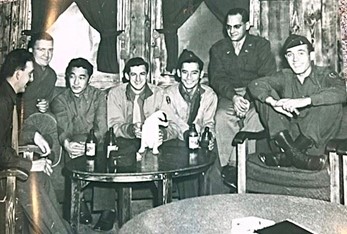
5th from left – Oyasato on Christmas Day, 1944
The 442nd returned to Italy on March 25, 1945, for the Po Valley Campaign. When Oyasato arrived in Pisa with his men, according to 442nd historian Eric Saul, he caused quite a stir with the Italians when he proclaimed, “We’re going to fix that tower there so that it won’t lean so much and be a hazard to our troops.”
On April 9, Henry C. Oyasato was wounded in action during the taking of the town of Pariana on the northern slope of Mt. Belvedere. He was promoted to 1st Lieutenant upon his quick recovery from his wounds.
After the war ended on May 8, 2nd Battalion moved from Alessandria to Asti, northwest of Genoa in the Piedmont region. On May 16, they moved to Ghedi Airport, near Brescia southwest of Lake Garda. Oyasato went on May 27 to the Fifth Army command post at Salò, on the western shore of the lake, in order to get his new officer ID card. After a few months at Ghedi, where they helped process POWs, F Company on August 20 moved to Livorno (Leghorn) to assume guard duties for POWs and installations. Over the next months, as men who had accrued enough “points” started to leave for home, some opted to remain in Livorno as occupation duties were light and life was good. They were housed in buildings with real beds to sleep in, and they had use of the PX (Post Exchange) with all its “goodies.” They were given passes to such places as Switzerland, Rome, and Monte Carlo. Company Commander Oyasato asked for a roster of the German POWs so that he could check their special talents. He requisitioned former hotel chefs – real bakers and cooks, plus waiters from among the POWs – to help cook for his men. Their food vastly improved after that.
Before Christmas 1945, another incident occurred that illustrated Oyasato’s kind nature when a nun was caught rummaging through the company’s garbage cans in search of food for her orphanage. After that, Oyasato arranged for all uneaten leftovers to be set aside for the nun. After getting to know the nuns and the Mother Superior, F Company decided to give a Christmas party for the orphanage. Each soldier was assigned a child to host at the party, including individual wrapped gifts from the PX.
On New Year’s Eve, 1945, Lt. Oyasato was still in Livorno with the Army of Occupation. The 442nd had returned to the U.S. the previous July, but some men were still in Italy guarding POWs. He later recalled that night at the stroke of midnight some of the men “were burning ammo powder as fireworks. Young Mikami… raised his rifle straight up in the air and fired his firecracker, or so he thought. All he did was to effectively cut the main telephone communication trunk line in and out of Leghorn.” Company Commander Oyasato realized he had to take disciplinary action and confined Mikami to company grounds for a week. When the area, regimental, and battalion commanders called to demand that Pfc. Mikami be court-marshaled, Oyasato told them that he could not to that – as he had already given him a company punishment and a court martial would be double jeopardy. The Battalion Commander was elated, “Good thinking, Hank!”
For his wartime service, First Lieutenant Henry Chiyei Oyasato was awarded the Silver Star Medal; Bronze Star Medal with one bronze oak leaf cluster; Purple Heart with one bronze oak leaf cluster; American Campaign Medal; European-African-Middle Eastern Campaign Medal with four bronze stars; World War II Victory Medal; Army of Occupation Medal; Combat Infantryman Badge; and Distinguished Unit Badge. He was awarded the Congressional Gold Medal on October 5, 2010, along with the other veterans of the 100th/442nd Regimental Combat Team. This is the highest Congressional Civilian Medal.
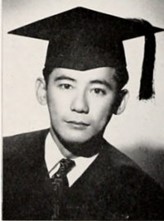
Sometime during 1946, Oyasato returned to Hawaii. In January 1947, he was at the University of Hawaii (UH) and on a student committee to raise money for the World Student Service Fund, whose goal was helping students in war-stricken countries in Europe and Asia to complete their education.
Hank earned his Bachelors degree in Economics/Business in 1948 at UH. During these last two years he was active in the YMCA and the Board of Publications (for the school newspaper and yearbook).
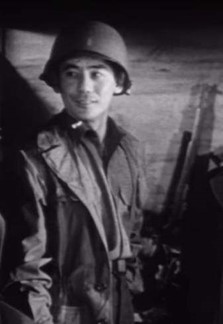
After the war, Oyasato was chosen for the part of Lt. Takashi “Irish” Ohhara, one of the six principal actors in the 1951 MGM movie, Go For Broke. His character was killed by artillery shrapnel in the Vosges Campaign, and his younger brother later enlisted in the Army.
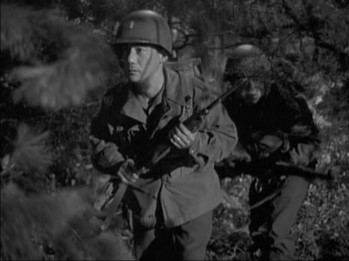
Capt. Henry C. Oyasato married Natsue Ogata on June 23, 1951, at St. Andrew’s Cathedral, in Honolulu. Their wedding reception was at the Cannon Club at Fort Ruger. At the time, he was on active duty with the Hawaiian infantry training center at Schofield Barracks and on leave from the U.S. Customs Service in Honolulu. His bride was a graduate of the University of Hawaii and did graduate work at Columbia University in New York City. She was currently a psychiatric social worker at Queen’s Hospital in Honolulu. Over the years, they raised a family of one son and one daughter.
In the 1960s and 1970s, Oyasato was a Colonel in the U.S. Army and serving as Director of the Selective Service System for Hawaii. He retired from the Army on March 31, 1980.
Henry Chiyei Oyasato died on April 6, 1994, in Honolulu. He was inurned in the Columbarium at the National Memorial Cemetery of the Pacific at Punchbowl, Plot CT3-H, Row 300, Site 322. Survivors included his wife and two children.
His brother Lt. George Chisei Oyasato served in the MIS in the Philippines during World War II.
